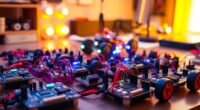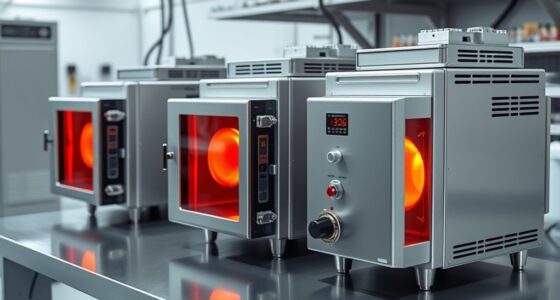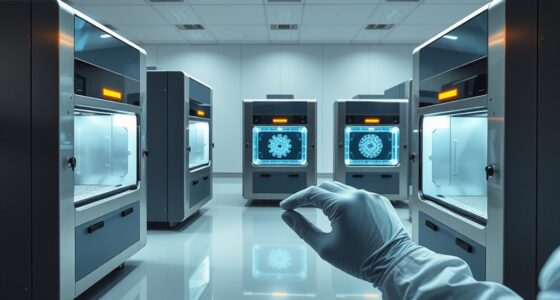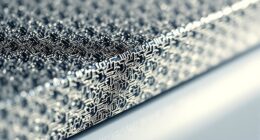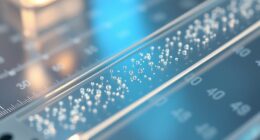If you’re exploring the best high-end 3D bioprinters of 2025 for precision and innovation, I’ve found that top models combine advanced multi-material capabilities, high-speed performance, large build volumes, and user-friendly automation features. These machines support diverse bioinks, enable multi-cell constructs, and maintain sterile environments for biomedical breakthroughs. If you want to discover which options lead the industry and how they can boost your projects, there’s plenty more to uncover ahead.
Key Takeaways
- High-end bioprinters in 2025 feature multi-material, multi-color capabilities for complex tissue and organ modeling.
- Advanced precision with resolutions as fine as 17 micrometers enables detailed, functional tissue structures.
- Enclosed, temperature-controlled chambers support sterile environments and biocompatible bioinks for medical applications.
- Automated workflows, including auto bed leveling and real-time monitoring, ensure consistent, high-quality bioprinting.
- Modular, multi-nozzle systems and high-speed printing accelerate research and production of complex biological constructs.
QIDI PLUS4 3D Printer
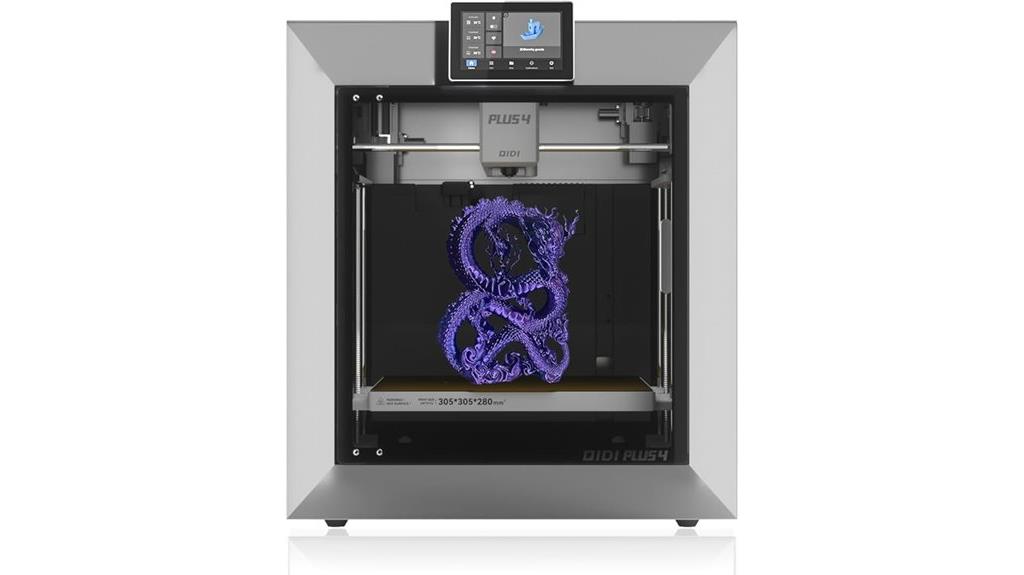
If you’re looking for a high-performance 3D printer that balances large build volume with professional-grade precision, the QIDI PLUS4 is an excellent choice. It boasts a sizable 12x12x11-inch print area, perfect for multiple models at once. Its sturdy build includes a high-speed Core XY structure, a dual motor-driven Z-axis, and a durable 6mm aluminum hot bed, ensuring high accuracy and flatness. The enclosed chamber supports high-temp filaments like ABS and PETG, while features like automatic leveling and remote monitoring make operation straightforward. Overall, the PLUS4 delivers reliable, fast, and precise printing, making it ideal for both professionals and serious hobbyists.
Best For: Professionals and serious hobbyists seeking a large-volume, high-precision 3D printer capable of handling diverse high-temperature filaments with ease.
Pros:
- Large build volume of 12x12x11 inches for multiple or sizable models
- High-speed Core XY structure with speeds up to 600mm/s for efficient printing
- Enclosed chamber with chamber heating supports advanced materials like ABS, PETG, and Nylon
Cons:
- Slightly bulky dimensions and weight may require dedicated space and setup effort
- Initial firmware bugs and hardware issues such as SSR overheating may need troubleshooting
- Lack of automatic power recovery after outages and filament storage placement could inconvenience some users
Bambu Lab A1 Combo 3D Printer and AMS Lite
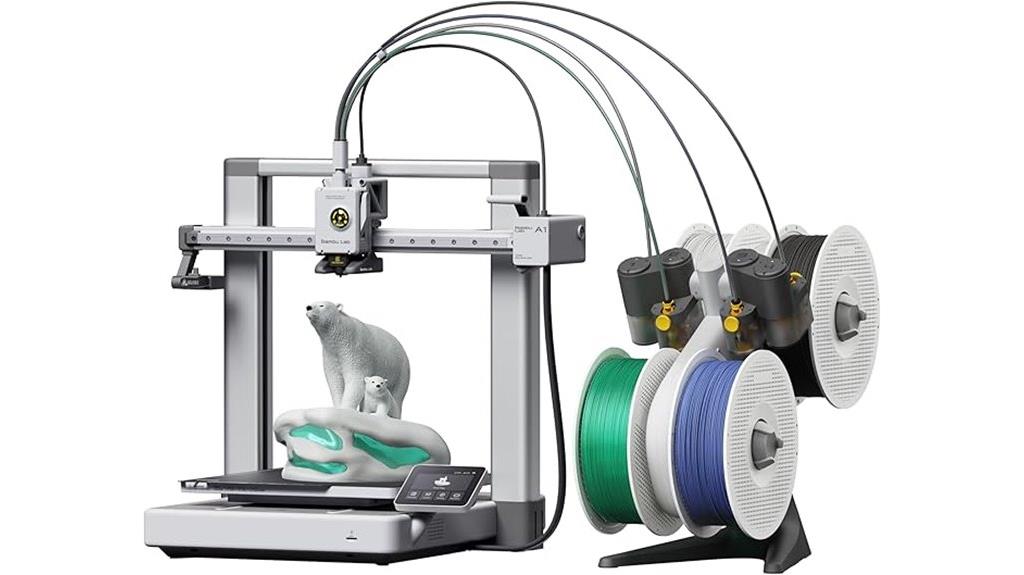
The Bambu Lab A1 Combo 3D Printer with AMS Lite stands out as an excellent choice for users seeking vibrant, multi-color printing with high speed and precision. Its support for multi-color prints, combined with acceleration up to 10,000 mm/s², ensures fast, detailed results. Automatic bed leveling and Z-offset adjustments make setup straightforward, while active flow rate compensation guarantees smooth extrusion and top-quality finishes. Quiet operation (≤48 dB) and an intuitive touchscreen enhance user experience. The quick-swap nozzle simplifies maintenance, and its reliable performance suits both hobbyists and small print farms. Overall, the A1 Combo excels in delivering high-speed, multi-color precision with ease of use.
Best For: hobbyists, small-scale print farms, and users seeking vibrant multi-color 3D prints with high speed and ease of use.
Pros:
- Supports multi-color printing with AMS Lite for detailed, vibrant designs
- High-speed acceleration up to 10,000 mm/s² for fast, precise printing
- Automatic calibration and Z-offset adjustment simplify setup and maintenance
Cons:
- Size requires ample space, approximately 60 cm depth including filament holder and exhaust
- Closed ecosystem limits customization compared to open-source solutions
- Occasional filament jams and parts durability issues reported after extensive use
FLASHFORGE Adventurer 5M 3D Printer

Designed for both beginners and experienced users, the FLASHFORGE Adventurer 5M stands out with its high-speed capabilities and user-friendly features, making it an excellent choice for rapid prototyping and creative projects. Its enclosed design, all-metal CoreXY structure, and fully automatic bed leveling simplify setup and maintenance. With a direct extruder reaching 280°C and a high-flow nozzle, it delivers fast, high-quality prints up to 600mm/s. The magnetic, self-leveling heated bed and quick nozzle changes enhance efficiency. Support for upgrades like enclosures and cameras, combined with reliable performance and intuitive controls, makes the Adventurer 5M a versatile, powerful tool for innovative 3D printing.
Best For: hobbyists, educators, and small-scale prototyping enthusiasts seeking a reliable, high-speed 3D printer with easy setup and versatile upgrade options.
Pros:
- Fast printing speeds up to 600mm/s with stable high-quality output
- User-friendly interface and fully automatic bed leveling for quick setup
- Enclosed design with support for upgrades like enclosures and cameras
Cons:
- Limited build volume of 220x220x220mm may restrict larger projects
- Slicer software (FlashPrint) is somewhat limited; better results may require switching to other programs
- Some users experience filament feeding issues or nozzle clogging over time
Creality K2 Plus Combo 3D Printer

For those seeking fast, high-quality multi-color 3D printing, the Creality K2 Plus Combo stands out with its ability to connect up to four CFS units for 16-color output. Its impressive max speed of 600mm/s, powered by step-servo motors and high acceleration, guarantees swift, quiet operation. The printer supports multiple materials like PLA, ABS, PETG, and more, thanks to an actively heated chamber and high-temp nozzle. Dual AI cameras monitor print progress, alerting me to issues in real-time. The sturdy frame, auto-leveling, and large 350mm cube build volume make it reliable for complex, multi-color projects, all in a user-friendly setup.
Best For: makers and professionals seeking rapid, high-quality multi-color 3D printing with versatile material support and advanced monitoring features.
Pros:
- Supports multi-color printing with up to 16 colors via four CFS units, reducing post-processing.
- High maximum speed of 600mm/s with quiet operation, enabling fast production.
- Equipped with dual AI cameras for real-time monitoring and alerts, enhancing reliability.
Cons:
- Heavy weight (approximately 116 pounds) and large size may require assistance for moving and setup.
- Some users have experienced technical issues such as communication failures or filament feeding problems.
- Higher price point compared to basic 3D printers, which may be a consideration for budget-conscious users.
FLASHFORGE AD5X Multi-Color 3D Printer
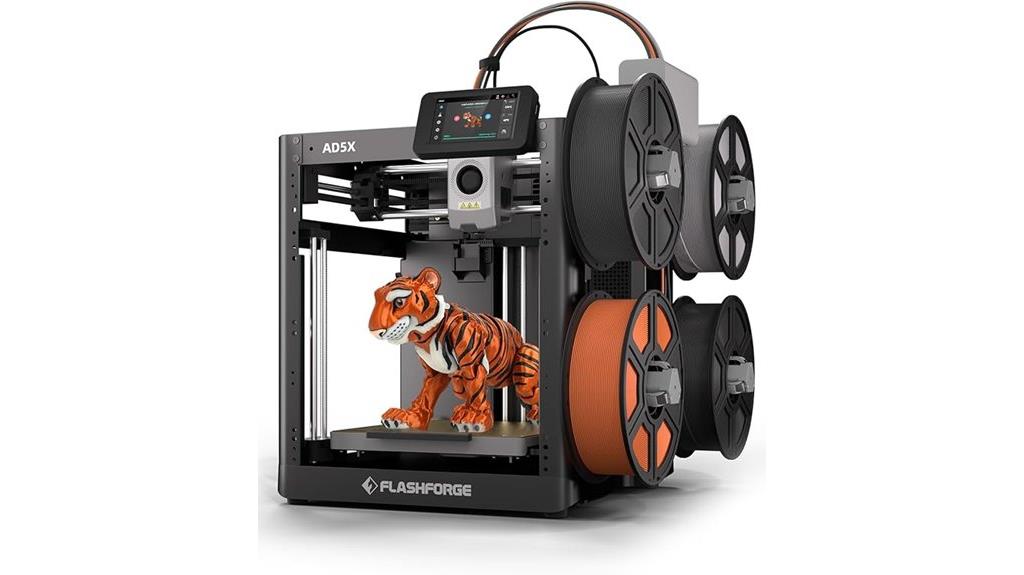
If you’re looking for a versatile, high-speed 3D printer capable of multi-color printing, the FLASHFORGE AD5X stands out as an excellent choice. It features a CoreXY structure that reaches speeds up to 600mm/s and acceleration of 20,000mm/s², making rapid prototyping effortless. Supporting four-color simultaneous printing, it’s perfect for detailed miniatures and large projects. The 300°C direct-drive extruder and interchangeable nozzles enable precision in complex designs. Its enclosed design, dual-channel cooling, and vibration compensation deliver exceptional quality while reducing noise and fumes. With user-friendly setup, auto-leveling, and a 220x220x220mm build volume, it’s ideal for both creative and practical applications.
Best For: hobbyists, educators, and small-scale professionals seeking fast, multi-color 3D printing with high precision and ease of use.
Pros:
- High-speed printing with speeds up to 600mm/s and quick setup features like 1-Click Auto Leveling
- Supports multi-color printing with up to four colors simultaneously, ideal for detailed and creative projects
- Enclosed design with noise reduction and fume management, suitable for indoor environments
Cons:
- Software stability issues on MacOS and limitations with support generation and auto-alignment of multiple STL files
- Proprietary file formats (.gx) and limited filament spool size (500g) may restrict workflow flexibility
- Noisy fans and outdated Wi-Fi interface can impact user experience and convenience
ELEGOO Centauri Carbon 3D Printer
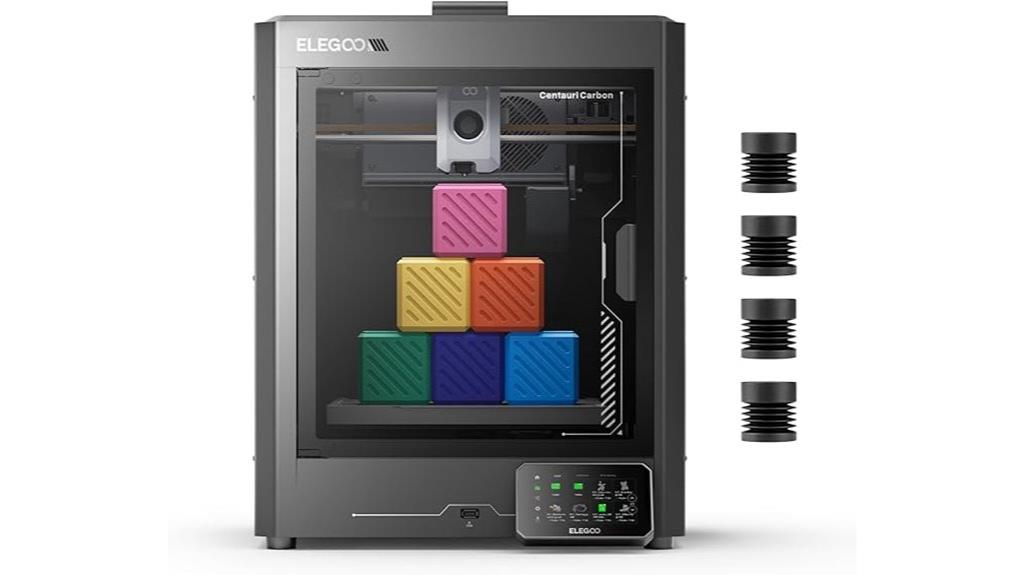
The ELEGOO Centauri Carbon 3D Printer stands out for its ready-to-use, user-friendly design, making it an excellent choice for both beginners and experienced makers looking to jump straight into high-quality bioprinting. It arrives fully assembled and pre-calibrated, with features like auto bed leveling, an intuitive touchscreen, and a sizable 256x256x256 mm build volume. Its high-speed CoreXY structure reaches speeds up to 500 mm/s, ensuring fast, reliable printing of complex parts. Equipped with a high-temperature hotend and enclosed chamber, it handles advanced filaments such as carbon fiber composites, producing strong, lightweight, heat-resistant components suitable for demanding applications.
Best For: hobbyists, educators, and professionals seeking a reliable, high-speed 3D printer capable of handling advanced filaments and producing precise, durable parts with ease.
Pros:
- Fully assembled, pre-calibrated, and user-friendly, suitable for immediate use by beginners and experts alike
- High-speed printing capabilities up to 500 mm/s with a stable CoreXY design for efficient production
- Enclosed chamber with advanced hotend allows for printing with specialized materials like carbon fiber composites
Cons:
- Larger build volume may require more space in the workspace
- High-speed operation might necessitate more frequent maintenance and calibration for optimal results
- Enclosed chamber and advanced features could lead to a steeper learning curve for complete beginners
FLASHFORGE AD5X 3D Printer with Multi-Color Printing

With its multi-color printing capabilities and high-speed performance, the FLASHFORGE AD5X 3D Printer stands out as an excellent choice for those seeking vibrant, detailed models without sacrificing efficiency. It features automatic leveling, vibration compensation, and a colorful 4.3-inch touchscreen for easy operation. Its all-metal CoreXY design supports speeds up to 600mm/s and handles various filaments, including PLA, PETG, TPU, and carbon fiber. The printer’s multi-filament system reduces manual intervention, making it ideal for both hobbyists and industrial applications. With a sizable build volume and reliable performance, the AD5X offers excellent value and adaptability for complex, multi-color projects.
Best For: hobbyists and small to medium-sized industrial users seeking reliable, high-speed multi-color 3D printing with versatile filament options.
Pros:
- Supports multi-color printing with an Intelligent Filament System, reducing manual filament changes
- Fast printing speeds up to 600mm/s with stable all-metal CoreXY construction
- User-friendly features like automatic leveling, vibration compensation, and a colorful touchscreen
Cons:
- Non-removable print bed may complicate print removal and post-processing
- Fan noise can be noticeable during operation
- Upgrading to print high-temperature or abrasive filaments requires additional modifications
Original Prusa CORE One 3D Printer with 1kg PLA Spool
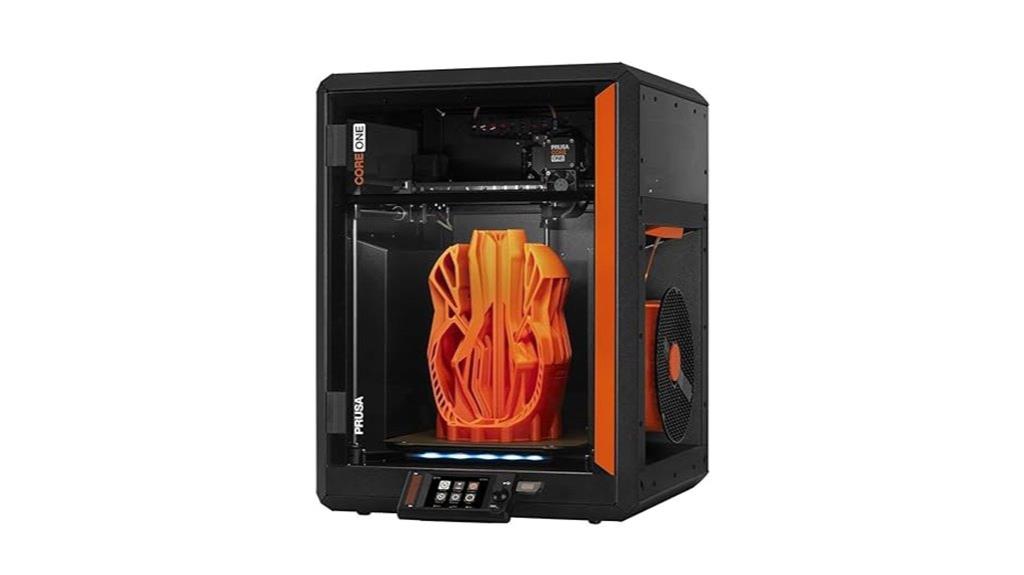
Designed for both beginners and experienced users, the Original Prusa CORE One 3D Printer stands out with its robust all-steel frame and enclosed chamber, ensuring consistent and high-quality prints across a variety of materials. Its premium build quality and active temperature control up to 55°C support versatile filament options like PLA, PETG, and Nylon. The CoreXY design delivers fast, precise printing within a large 250×220×270mm volume. Easy to set up and operate, it includes a 1kg spool of Prusament PLA in Prusa Galaxy Black. Plus, Prusa’s lifetime support guarantees reliable performance and ongoing assistance.
Best For: hobbyists, educators, and small-scale professionals seeking a reliable, high-quality 3D printer with versatile material support and easy setup.
Pros:
- Durable all-steel frame and enclosed chamber for consistent printing and material versatility
- Large build volume (250×220×270mm) suitable for diverse projects and complex models
- User-friendly setup with quick first prints and lifetime technical support from Prusa
Cons:
- Enclosed chamber may require careful maintenance to ensure optimal temperature control over time
- Higher initial investment compared to entry-level printers with fewer features
- Limited to filament-based printing, not suitable for resin or other advanced 3D printing technologies
Creality K2 Plus 3D Printer with Multi-Color Printing
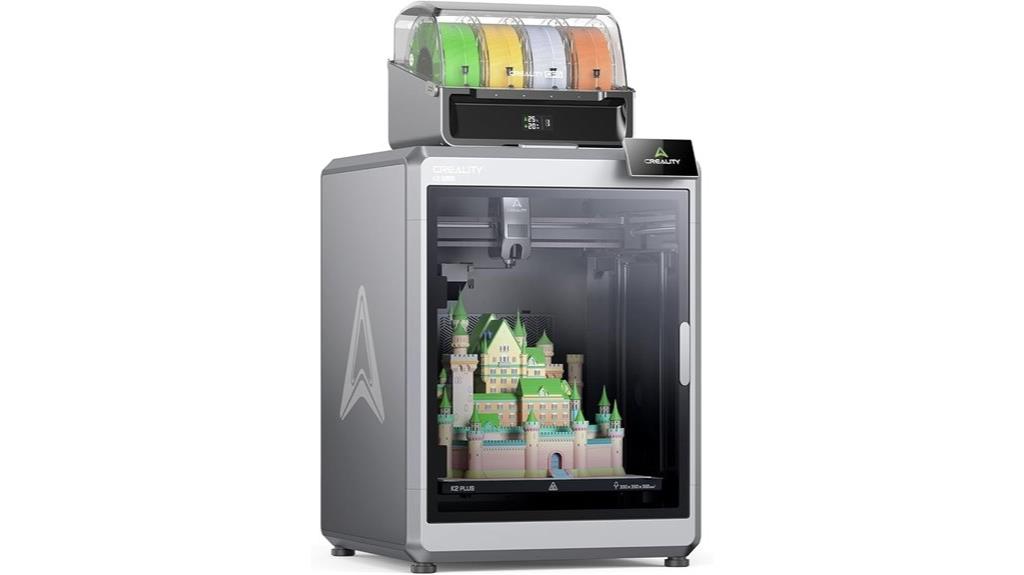
If you’re aiming to produce large, complex, multi-colored models with high precision, the Creality K2 Plus 3D Printer stands out as an excellent choice. Its expansive 350×350×350mm build volume handles big projects easily, while the aerospace-grade aluminum frame guarantees stability and durability. The innovative CFS system allows simultaneous filament storage and blends up to 16 colors within a single print, simplifying multicolor designs. With speeds up to 600mm/s and a 0.05mm layer resolution, it balances rapid production with fine detail. Intelligent monitoring with AI cameras and sensors reduces failures, making it a reliable, high-performance option for advanced multi-material, multi-color printing.
Best For: hobbyists, educators, and professionals seeking large-scale, multi-color, high-precision 3D printing for complex and detailed models.
Pros:
- Large 350×350×350mm build volume suitable for big projects and multi-part assemblies
- Advanced multicolor system with up to 16 color blending for vibrant, multi-hued prints
- High speed (600mm/s) and fine resolution (0.05mm) combined with quiet operation and reliable monitoring
Cons:
- Filaments are not included, requiring additional purchase and management
- The multi-color system may require technical setup and calibration for optimal results
- Potentially higher cost and complexity compared to standard single-color 3D printers
FLASHFORGE AD5M 3D Printer with Auto Calibration and Quick-Swap Nozzle
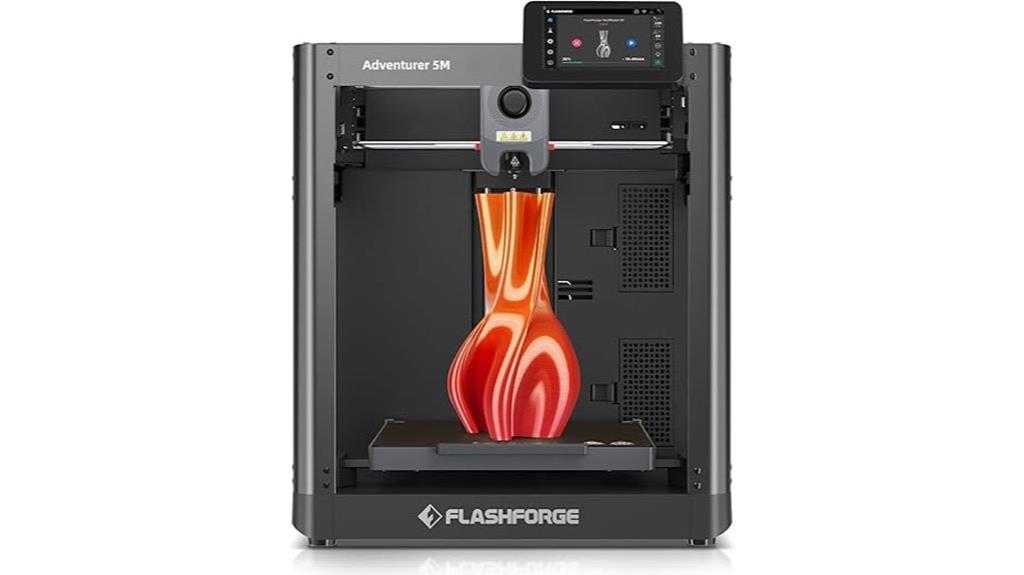
The FLASHFORGE AD5M stands out for its auto calibration and quick-swap nozzle system, making it an ideal choice for both beginners and experienced users who need reliable, high-quality prints with minimal setup time. Its fully automatic one-click leveling assures perfect first layers every time, while the flexible double-sided PEI steel plate simplifies removal and supports PETG printing. The quick-release nozzle system allows swaps in just three seconds, accommodating various diameters for precision or efficiency. With high-speed capabilities up to 600mm/s and robust motion, it delivers fast, accurate results. Remote control and safety features further enhance the user experience, making the AD5M a versatile, high-end option.
Best For: both beginners looking for an easy-to-use 3D printer and professionals requiring high-speed, precise, and reliable printing capabilities.
Pros:
- Fully automatic one-click leveling system ensures perfect first layers with minimal effort
- Quick-swap nozzle system allows for rapid changes, supporting multiple filament diameters and types
- High-speed printing up to 600mm/s with stable, low-noise operation for efficient large-volume or detailed projects
Cons:
- Advanced features may have a learning curve for complete beginners
- The all-metal CoreXY structure might require regular maintenance to ensure optimal performance
- Higher price point compared to entry-level 3D printers, which could be a consideration for budget-conscious users
FLASHFORGE Adventurer 5M Pro 3D Printer
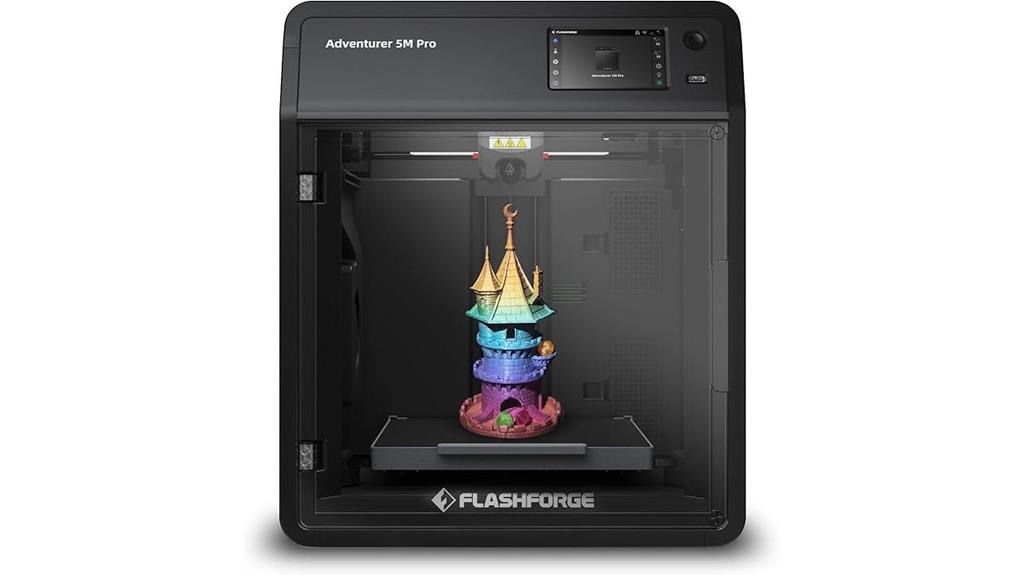
For those seeking a reliable, user-friendly 3D printer capable of rapid, high-quality builds, the FLASHFORGE Adventurer 5M Pro stands out as a strong option. It features a top speed of 600mm/s and heats the nozzle to 200°C in just 35 seconds, streamlining the printing process. Its all-metal core XY structure and direct extruder support diverse materials like PLA, ABS, PETG, and composites. The self-leveling magnetic bed ensures perfect first layers with minimal effort, while the enclosed design reduces noise and improves print quality. With WiFi connectivity, mobile app control, and quick setup, it’s ideal for both beginners and experienced users seeking efficiency and precision.
Best For: hobbyists, beginners, and educators seeking a reliable, easy-to-use 3D printer with fast setup and high-quality output.
Pros:
- Quick and straightforward setup with minimal calibration required
- Supports a wide range of materials, including flexible and composite filaments
- Enclosed design reduces noise and improves print quality, ideal for small spaces
Cons:
- Small build volume (220x220x220mm) may limit larger projects
- Potential issues with filament feeding and nozzle clogs with extensive use
- WiFi connectivity and camera quality may be less reliable or of lower quality
ELEGOO Neptune 3 Pro 3D Printer with Auto Bed Leveling
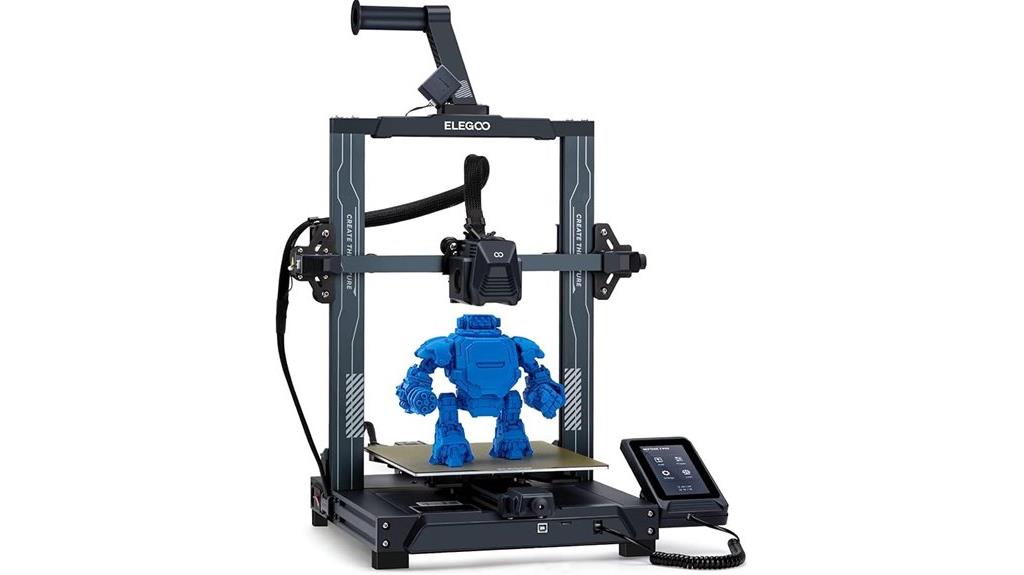
As someone seeking reliable and precise 3D bioprinting, the ELEGOO Neptune 3 Pro stands out with its auto bed leveling system, which simplifies setup and guarantees consistent print quality. With a 225x225x280mm build volume, it’s suitable for a variety of projects. Its dual synchronized lead screws and dual-motor Z-axis ensure stable, accurate movement, while the POM V-guide rails minimize noise and wear. The direct SUS303 stainless steel extruder handles multiple filament types smoothly, and the high-precision sensor scans 36 points for auto leveling. Quiet stepper motors and intelligent filament management make it a versatile, user-friendly choice for high-end bioprinting needs.
Best For: hobbyists, educators, and small-scale professionals seeking reliable, precise 3D printing with auto bed leveling and versatile filament compatibility.
Pros:
- Auto bed leveling with high-precision sensor for consistent print quality
- Stable dual Z-axis lead screws and silent stepper motors ensure accurate, quiet operation
- Compatible with multiple filament types including PLA, TPU, PETG, and ABS
Cons:
- Slightly limited build volume compared to larger 3D printers
- Assembly may require some initial setup despite pre-assembled components
- Noise level, while reduced, may still be noticeable in very quiet environments
ANYCUBIC Photon Mono 4 Resin 3D Printer

If you’re seeking a high-precision resin 3D printer capable of producing intricate, detailed models, the ANYCUBIC Photon Mono 4 stands out as an excellent choice. It features a 7.10K Mono LCD screen with a resolution of 9024×5120, delivering 17×17μm pixel size for exceptional detail. Its generous build volume of 6.04 x 3.42 x 6.49 inches supports complex projects. Equipped with a stable LighTurbo light source and a laser-engraved print platform, it minimizes layer lines and warping. User-friendly with a 4-point leveling system and resume function, it’s perfect for demanding applications and offers reliable, high-quality results.
Best For: hobbyists and professionals seeking high-precision, detailed resin 3D prints with reliable performance and user-friendly features.
Pros:
- High-resolution 7.10K Mono LCD with 17×17μm pixel size for exceptional detail
- Large build volume of 6.04 x 3.42 x 6.49 inches suitable for complex projects
- Easy 4-point leveling system and resume printing function for convenience and efficiency
Cons:
- Does not support Anycubic APP services, limiting connectivity options
- Weighs 7.7 pounds, which may affect portability and workspace setup
- Slightly higher price point compared to entry-level resin printers
Bambu Lab A1 Mini 3D Printer and AMS Lite

The Bambu Lab A1 Mini 3D Printer combined with the AMS Lite is an excellent choice for users seeking high-speed, multi-color 3D printing with minimal calibration effort. It features full-auto calibration, ensuring quick setup and consistent results, while active flow rate compensation guarantees smooth, flawless extrusion across various materials. With a quiet operation level of ≤48 dB, it creates a comfortable workspace. The user-friendly touchscreen and pre-assembled design make it accessible for beginners and experts alike. Quick nozzle swaps via the 1-Clip system streamline maintenance, allowing for versatile, efficient printing. Overall, this setup offers precision, speed, and ease of use in a compact form.
Best For: hobbyists, educators, and small-scale professionals seeking high-speed, multi-color 3D printing with easy setup and minimal calibration.
Pros:
- Supports multi-color printing via AMS Lite for vibrant, detailed models
- Full-auto calibration simplifies setup and ensures consistent quality
- Quiet operation at ≤48 dB creates a comfortable workspace
Cons:
- AMS Lite is sold separately or only with the combo, adding additional cost
- Limited build volume compared to larger industrial 3D printers
- May require familiarity with 3D printing to optimize advanced features
Factors to Consider When Choosing High‑End 3D Bioprinters
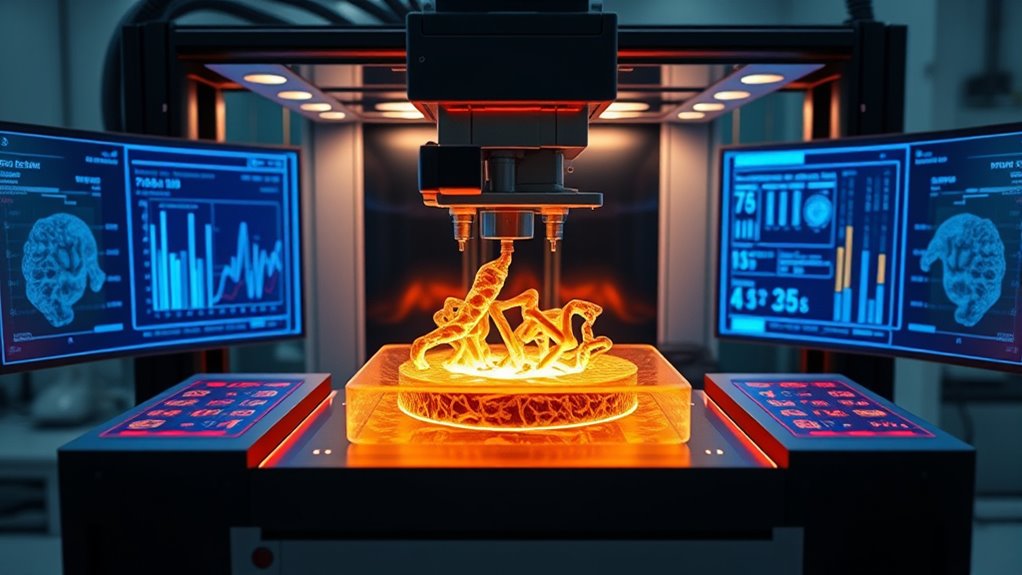
When selecting a high-end 3D bioprinter, I focus on key factors like precision and resolution to guarantee detailed results. Material compatibility and printing speed also matter to meet diverse project needs efficiently. Additionally, I consider biocompatibility standards and chamber environment control to maintain safety and consistency.
Precision and Resolution
High-end 3D bioprinters excel in delivering resolutions as fine as 17 micrometers, which allows for highly precise layer-by-layer deposition essential for complex tissue structures. Achieving this level of detail relies on high-precision nozzles, typically with diameters between 10 and 100 micrometers, to control cell and material placement accurately. Advanced systems often incorporate multi-nozzle setups or dynamic extrusion controls, enhancing resolution and enabling multi-material or multi-cell-type printing. The resolution directly impacts the surface finish, structural fidelity, and cellular integration of the printed constructs. However, high resolution must be balanced with other factors like throughput and material compatibility, ensuring the bioprinter meets the specific demands of sophisticated tissue engineering applications without compromising efficiency.
Material Compatibility
Choosing the right bioprinter requires careful consideration of material compatibility, as it directly influences the range of tissues and applications you can pursue. High-end 3D bioprinters must support a broad spectrum of biomaterials, including hydrogels, bioinks, and cell-laden matrices, to suit diverse tissue engineering needs. Compatibility with high-temperature thermoplastics like PEEK and PEKK is also essential for creating durable, implant-grade scaffolds and devices. Ensuring the printer can handle sterile, non-toxic, cell-compatible materials is indispensable for safety and cell viability. Many advanced models feature multi-nozzle setups or modular heads, enabling simultaneous or sequential use of different materials for complex tissues. Material versatility, including conductive or biodegradable options, expands possibilities in regenerative medicine and research.
Printing Speed
Printing speed plays a significant role in the performance of advanced 3D bioprinters, especially when working with complex or large tissue constructs. High-end models can reach speeds of 600 mm/s or more, allowing rapid layer deposition. Faster printing reduces overall production time, but it demands precise calibration and stable motion systems to maintain accuracy. Achieving high speeds requires powerful components like linear rails and high-torque stepper motors to prevent layer shifting and guarantee resolution. Multi-material and multi-nozzle bioprinters can switch bioinks quickly, boosting throughput for multi-tissue constructs. However, balancing speed with cell viability and structural integrity is vital, as excessive speeds might introduce shear stress or compromise print quality. Selecting the right speed depends on your project’s complexity and quality requirements.
Biocompatibility Standards
Ensuring biocompatibility is essential when selecting a 3D bioprinter, as it directly impacts the safety and success of biological applications. High-end bioprinters must use materials that meet strict standards like ISO 10993 and USP Class VI to guarantee safety for human contact and biological integration. These standards help prevent cytotoxicity, immunogenic responses, and adverse reactions. Regulatory compliance is vital for clinical, tissue engineering, and implantable applications, guaranteeing consistent safety and performance. Biocompatibility testing includes assessments of cytotoxicity, sensitization, irritation, and systemic toxicity, validating the suitability of printed constructs for medical use. Many top-tier bioprinters incorporate certified biocompatible materials and adhere to evolving standards, supporting a smooth transition from research to clinical and commercial deployment.
Chamber Environment Control
Maintaining a stable chamber environment is vital for high-end 3D bioprinters, as it directly affects cell viability and material integrity during the printing process. Precise control over temperature, humidity, and airflow ensures consistency and minimizes fluctuations that could compromise the quality of biological constructs. Active temperature regulation, often reaching up to 60°C or higher, prevents warping and layer delamination, especially with temperature-sensitive bioinks and cell-laden materials. Dual-layer insulation and efficient air circulation systems help stabilize internal conditions, reducing variability. Real-time monitoring paired with automated adjustments ensures ideal parameters are maintained throughout long printing sessions. Additionally, strict chamber environment control minimizes contamination risks and sustains sterile conditions, which are vital for producing viable tissues and maintaining the integrity of sensitive biological materials.
Software and Firmware
Choosing the right software and firmware is key to revealing the full potential of high-end 3D bioprinters. Advanced firmware provides precise control over critical parameters like temperature, pressure, and extrusion rate, which are crucial for handling delicate biological materials. Regular firmware updates ensure compatibility with new bioinks, enhance print stability, and introduce features like real-time monitoring and error correction. Many professional bioprinters use open-source firmware, allowing customization for specialized tissue engineering needs. User-friendly software interfaces with intuitive GUIs, real-time visualization, multi-material management, and automated calibration routines help ensure consistent, high-quality results. Compatibility with various design and slicing software, including proprietary solutions optimized for biological structures, is essential for streamlining workflows and maximizing the bioprinter’s capabilities.
Support and Maintenance
When investing in a high-end 3D bioprinter, it’s essential to evaluate the quality of support and maintenance services. These systems involve complex hardware and software, so prompt technical assistance is indispensable to minimize downtime. Regular calibration, cleaning, and part replacement are necessary to maintain peak print quality and extend the machine’s lifespan. Compatibility with specialized bioprinting materials and firmware updates requires manufacturers to offer extensive support channels, including troubleshooting guides, remote diagnostics, and expert assistance. Access to spare parts and upgrade options ensures sustained high performance and adaptability to new applications. Ultimately, reliable support and proactive maintenance are key to maximizing your investment and ensuring consistent, innovative results in bioprinting.
Frequently Asked Questions
How Do Bioprinting Resolution and Layer Accuracy Impact Tissue Viability?
Bioprinting resolution and layer accuracy are vital for tissue viability because they determine how well cells are positioned and how closely the printed tissue mimics natural structures. Higher resolution leads to finer detail, promoting better cell integration and function. Precise layering ensures consistency, reduces defects, and enhances nutrient flow. I believe investing in advanced bioprinters with superior resolution directly improves the success and longevity of bioprinted tissues.
What Sterilization Protocols Are Compatible With These High-End Bioprinters?
I guarantee sterilization protocols for high-end bioprinters include autoclaving, ethylene oxide gas, and UV sterilization, depending on the printer’s materials and components. I always verify compatibility first, as some sterilization methods can damage sensitive parts or bio-inks. Proper sterilization is essential to prevent contamination and maintain tissue viability, so I follow manufacturer guidelines meticulously and regularly monitor sterilization effectiveness throughout the process.
Can These Printers Handle Multiple Bio-Inks Simultaneously?
Absolutely, these top-tier bioprinters can handle multiple bio-inks simultaneously, almost like a symphony conductor guiding a diverse orchestra. I’ve seen them flawlessly switch between materials, creating complex, multi-layered tissues in a single run. This capability opens doors to astonishing breakthroughs in regenerative medicine, allowing us to craft intricate, functional biological structures with breathtaking precision and speed. It’s truly a marvel of modern technology!
What Is the Expected Lifespan and Maintenance Frequency for Optimal Performance?
I expect the lifespan of these high-end bioprinters to be around 5 to 10 years with proper maintenance. Regular cleaning, calibration, and software updates are essential for peak performance. I recommend monthly checks and annual servicing by professionals. Staying on top of maintenance not only prolongs the equipment’s life but also ensures consistent precision and innovation in your bioprinting projects.
How Do Bioprinter Software Updates Influence Ongoing Research Projects?
Oh, software updates? They’re like that mysterious cousin who shows up unannounced—annoying yet necessary. They keep my bioprinter’s software cutting-edge, ensuring my research stays relevant and precise. Plus, they fix bugs and introduce new features, making ongoing projects smoother. Skipping updates? That’s like ignoring a GPS and getting lost in the lab. So, I make sure to keep the software current for peak performance and innovation.
Conclusion
Choosing the right high-end 3D bioprinter can seem intimidating, but with these top options, you’re well on your way to precision and innovation. Do you see how each model offers unique features to push your projects forward? Whether you’re crafting intricate tissues or advancing research, these printers open endless possibilities. So, are you ready to take the leap into the future of bioprinting? Your groundbreaking work starts now.

